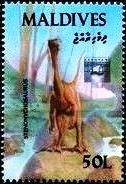Stamp: Stenonychosaurus (Maldives 1992)
Stenonychosaurus (Maldives 1992)
15 September (Maldives ) within release Dinosaurs goes into circulation Stamp Stenonychosaurus face value 50 Maldivian laari
| Stamp Stenonychosaurus in catalogues | |
|---|---|
| Michel: | Mi: MV 1776 |
| Stamp Number: | Sn: MV 1730 |
Stamp is square format.
Also in the issue Dinosaurs:
- Stamp - Iguanodon face value 3.50;
- Stamp - Stenonychosaurus face value 50;
- Stamp - Styracosaurus face value 10;
- Souvenir Sheet - Hadrosaur face value 25;
- Stamp - Anatosaurus face value 4;
- Stamp - Euoplocephalus face value 10;
- Stamp - Mamenchisaurus face value 25;
- Stamp - Scalidosaurus face value 1.25;
- Stamp - Tyrannosaurus face value 1.75;
- Stamp - Brachiosaurus face value 8;
- Souvenir Sheet - Tyrannosaurus, triceratops face value 25;
- Stamp - Monoclonius face value 5;
- Souvenir Sheet - Iguanodon allosaurus face value 25;
- Stamp - Deinonychus face value 5;
- Stamp - Stegosaurus face value 2;
- Stamp - Parasaurolophus face value 1;
- Stamp - Apatosaurus face value 50;
- Souvenir Sheet - Brachiosaurus, iguanodons face value 25;
- Stamp - Triceratops face value 25;
- Stamp - Tenontosaurus face value 7;
|
Data entry completed
46%
|
|
|---|---|
| Stamp Stenonychosaurus in digits | |
| Country: | Maldives |
| Date: | 1992-09-15 |
| Emission: | Commemorative |
| Format: | Stamp |
| Face Value: | 50 Maldivian laari |
Stamp Stenonychosaurus it reflects the thematic directions:
Animals are multicellular, eukaryotic organisms of the kingdom Animalia (also called Metazoa). All animals are motile, meaning they can move spontaneously and independently, at some point in their lives. Their body plan eventually becomes fixed as they develop, although some undergo a process of metamorphosis later on in their lives. All animals are heterotrophs: they must ingest other organisms or their products for sustenance.
Dinosaurs are a diverse group of reptiles of the clade Dinosauria. They first appeared during the Triassic period, between 243 and 233.23 million years ago (mya), although the exact origin and timing of the evolution of dinosaurs is a subject of active research. They became the dominant terrestrial vertebrates after the Triassic–Jurassic extinction event 201.3 mya and their dominance continued throughout the Jurassic and Cretaceous periods. The fossil record shows that birds are feathered dinosaurs, having evolved from earlier theropods during the Late Jurassic epoch, and are the only dinosaur lineage known to have survived the Cretaceous–Paleogene extinction event approximately 66 mya. Dinosaurs can therefore be divided into avian dinosaurs—birds—and the extinct non-avian dinosaurs, which are all dinosaurs other than birds.
Reptiles are tetrapod (four-limbed vertebrate) animals in the class Reptilia, comprising today's turtles, crocodilians, snakes, amphisbaenians, lizards, tuatara, and their extinct relatives. The study of these traditional reptile orders, historically combined with that of modern amphibians, is called herpetology. Because some reptiles are more closely related to birds than they are to other reptiles (e.g., crocodiles are more closely related to birds than they are to lizards), the traditional groups of "reptiles" listed above do not together constitute a monophyletic grouping (or clade). For this reason, many modern scientists prefer to consider the birds part of Reptilia as well, thereby making Reptilia a monophyletic class.



